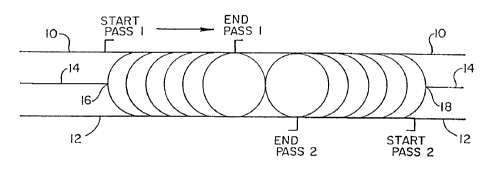Une partie des informations de ce site Web a été fournie par des sources externes. Le gouvernement du Canada n'assume aucune responsabilité concernant la précision, l'actualité ou la fiabilité des informations fournies par les sources externes. Les utilisateurs qui désirent employer cette information devraient consulter directement la source des informations. Le contenu fourni par les sources externes n'est pas assujetti aux exigences sur les langues officielles, la protection des renseignements personnels et l'accessibilité.
L'apparition de différences dans le texte et l'image des Revendications et de l'Abrégé dépend du moment auquel le document est publié. Les textes des Revendications et de l'Abrégé sont affichés :
| (12) Brevet: | (11) CA 2269558 |
|---|---|
| (54) Titre français: | PROCEDE DE SOUDAGE AMELIORE |
| (54) Titre anglais: | IMPROVED WELDING METHOD |
| Statut: | Réputé périmé |
| (51) Classification internationale des brevets (CIB): |
|
|---|---|
| (72) Inventeurs : |
|
| (73) Titulaires : |
|
| (71) Demandeurs : |
|
| (74) Agent: | PIASETZKI NENNIGER KVAS LLP |
| (74) Co-agent: | |
| (45) Délivré: | 2006-01-10 |
| (86) Date de dépôt PCT: | 1997-08-27 |
| (87) Mise à la disponibilité du public: | 1998-04-30 |
| Requête d'examen: | 2002-06-04 |
| Licence disponible: | S.O. |
| (25) Langue des documents déposés: | Anglais |
| Traité de coopération en matière de brevets (PCT): | Oui |
|---|---|
| (86) Numéro de la demande PCT: | PCT/US1997/015058 |
| (87) Numéro de publication internationale PCT: | WO1998/017435 |
| (85) Entrée nationale: | 1999-04-21 |
| (30) Données de priorité de la demande: | ||||||
|---|---|---|---|---|---|---|
|
L'invention a trait à un procédé de soudage permettant d'améliorer la durabilité et la résistance de joints de soudage par fusion dans des structures métalliques; le procédé est particulièrement avantageux pour des structures métalliques en alliage de nickel-titane (nitinol) et pour des dispositifs médicaux.
A welding method for improving the durability and strength of fusion weld
joints in metal structures; the method is especially
beneficial for metal structures fabricated from nickel-titanium alloy
(nitinol) and for medical devices.
Note : Les revendications sont présentées dans la langue officielle dans laquelle elles ont été soumises.
Note : Les descriptions sont présentées dans la langue officielle dans laquelle elles ont été soumises.

Pour une meilleure compréhension de l'état de la demande ou brevet qui figure sur cette page, la rubrique Mise en garde , et les descriptions de Brevet , États administratifs , Taxes périodiques et Historique des paiements devraient être consultées.
| Titre | Date |
|---|---|
| Date de délivrance prévu | 2006-01-10 |
| (86) Date de dépôt PCT | 1997-08-27 |
| (87) Date de publication PCT | 1998-04-30 |
| (85) Entrée nationale | 1999-04-21 |
| Requête d'examen | 2002-06-04 |
| (45) Délivré | 2006-01-10 |
| Réputé périmé | 2011-08-29 |
Il n'y a pas d'historique d'abandonnement
Les titulaires actuels et antérieures au dossier sont affichés en ordre alphabétique.
| Titulaires actuels au dossier |
|---|
| BOSTON SCIENTIFIC LIMITED |
| Titulaires antérieures au dossier |
|---|
| SCIMED LIFE SYSTEMS, INC. |
| WALAK, STEVEN E. |